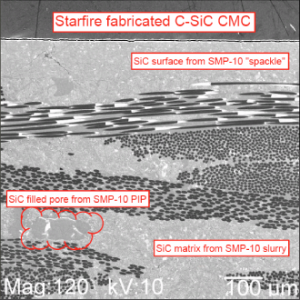Ceramic Forming Polymers
Starfire® Systems produces two families of ceramic forming polymers:
Silicon Carbide (SiC) – Polycarbosilane Based
 These proprietary Starfire® Systems polymers are our original technology and yield near stoichiometric SiC ceramics when converted. They are our highest strength polymers, thermally stable to 2500°C +, and available in new, hot melt versions.
These proprietary Starfire® Systems polymers are our original technology and yield near stoichiometric SiC ceramics when converted. They are our highest strength polymers, thermally stable to 2500°C +, and available in new, hot melt versions.
Starfire’s advanced technology offers a polymer route to near stoichiometric silicon carbides, delivering the benefits of SiC ceramic composites without the sintering and machining challenges. Our polymers form a high-strength green part with cure temperatures as low as 200°C and then form SiCs with nanoscale grain sizes as low as 800°C.
Highlights:
- Ability to mold complex, near net-shaped ceramic composite components
- Features a low temperature green cure
- Ceramic is formed using low cost furnaces
- Nanoscale ceramic grain yields tough parts
- Products are flexible – they feature low viscosity for infiltration or hot melt for layups
- Materials are lightweight, corrosion resistant, and temperature resistant
- Materials increase friction while reducing wear
Applications:
- SiC ceramic matrix composite components
- Infiltrate low cost preform for enhanced performance
- Suitable for a variety of structural, thermal, or friction uses
Silicon Oxycarbide (SiOC) – Polysiloxane Based
Our silicon oxycarbide resins are Starfire® Systems’ newest technology that is specifically designed to offer a tough, durable ceramic for moderate service temperatures. Starfire® Systems’ technology produces low cost, high performance silicon oxycarbide ceramics with configurable properties.
We have the ability to customize the ratios of Si-O-C and have the most cost effective ceramic formers on the market with services up to 1200°C.
Highlights:
- Strong cost / performance value proposition
- Mold complex near net-shaped ceramic composite parts
- Composite design flexibility (e.g., 2D layup, preform, BMC)
- Green cure in conventional presses and molds
- Low cost furnaces for firing ceramic
- Configurable ratio of Si-O-C in ceramic
- Lightweight, corrosion, and temperature resistant
Applications:
- Ceramics up to 1200°C
- Oxidation protective coatings to at least 1200°C
- Ceramic Matrix forming by conventional techniques (e.g., RTM, VARTM, slip casting, infiltrating)
